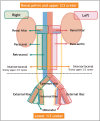Need for and extent of lymph node dissection for upper tract urothelial carcinoma: an updated review in 2023
- PMID: 37014743
- PMCID: PMC10256309
- DOI: 10.1097/MOU.0000000000001097
Need for and extent of lymph node dissection for upper tract urothelial carcinoma: an updated review in 2023
Abstract
Purpose of review: Although lymph node dissection (LND) during radical nephroureterectomy (RNU) is recommended for high-risk nonmetastatic upper tract urothelial carcinoma (UTUC), adherence to guidelines remains insufficient in clinical practice. Therefore, this review aims to comprehensively summarize the current evidence regarding the diagnostic, prognostic, and therapeutic impact of LND during RNU in UTUC patients.
Recent findings: Clinical nodal staging using conventional CT scan has low sensitivity (25%) and diagnostic accuracy [area under the curve (AUC): 0.58] in UTUC, suggesting the importance of LND for obtaining accurate N-staging. Patients with pathological node-positive (pN+) disease have poor disease-free survival (DFS), cancer-specific survival (CSS), and overall survival (OS) compared with those with pN0. In addition, population-based studies showed that patients who underwent LND improved CSS and OS than those who did not, even in patients who received adjuvant systemic therapy. The number of lymph nodes removed has also been shown to be associated with improved CSS and OS, even in pT0 patients. Template-based LND should be performed as the extent of lymph node is more important than the number of lymph nodes. Robot-assisted RNU may facilitate performing a meticulous LND compared with a laparoscopic approach. Postoperative complications such as lymphatic and/or chylous leakage are increased but adequately manageable. However, the current evidence is not supported by high-quality studies.
Summary: Based on the published data, LND during RNU is a standard procedure for high-risk nonmetastatic UTUC, owing to its diagnostic, staging, prognostic, and, potentially, therapeutic benefits. Template-based LND should be offered to all patients who are planned for RNU for high-risk nonmetastatic UTUC. Patients with pN+ disease are optimal candidates for adjuvant systemic therapy. Robot-assisted RNU may facilitate meticulous LND compared with laparoscopic RNU.
Copyright © 2023 The Author(s). Published by Wolters Kluwer Health, Inc.
Conflict of interest statement
Figures
References
-
- Kawada T, Laukhtina E, Quhal F, et al. . Oncologic and safety outcomes for endoscopic surgery versus radical nephroureterectomy for upper tract urothelial carcinoma: an updated systematic review and meta-analysis. Eur Urol Focus 2022; doi: 10.1016/j.euf.2022.11.016. [Epub ahead of print]. - PubMed
-
- Laukhtina E, Kawada T, Quhal F, et al. . Oncologic and safety outcomes for retrograde and antegrade endoscopic surgeries for upper tract urothelial carcinoma: a systematic review and meta-analysis. Eur Urol Focus 2022; doi: 10.1016/j.euf.2022.11.014. [Epub ahead of print]. - PubMed
-
- Katayama S, Mori K, Schuettfort VM, et al. . Accuracy and clinical utility of a tumor grade- and stage-based predictive model in localized upper tract urothelial carcinoma. Eur Urol Focus 2022; 8:761–768. - PubMed
-
- Foerster B, Abufaraj M, Matin SF, et al. . Pretreatment risk stratification for endoscopic kidney-sparing surgery in upper tract urothelial carcinoma: an international collaborative study. Eur Urol 2021; 80:507–515. - PubMed
-
- Marcq G, Foerster B, Abufaraj M, et al. . Novel classification for upper tract urothelial carcinoma to better risk-stratify patients eligible for kidney-sparing strategies: an international collaborative study. Eur Urol Focus 2022; 8:491–497. - PubMed
Publication types
MeSH terms
LinkOut - more resources
Full Text Sources
Medical
Research Materials



